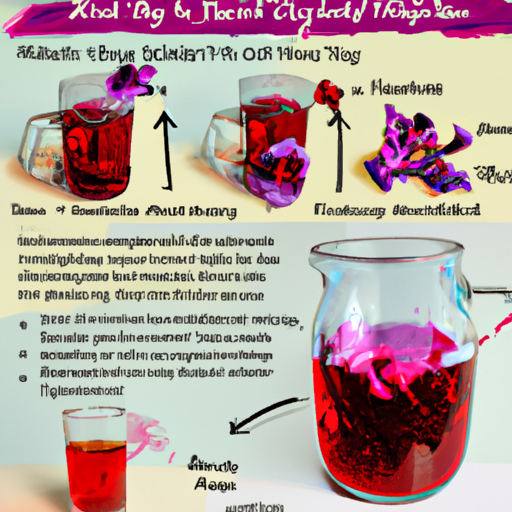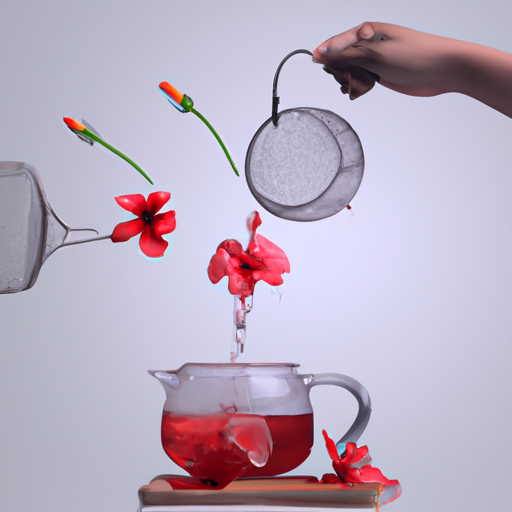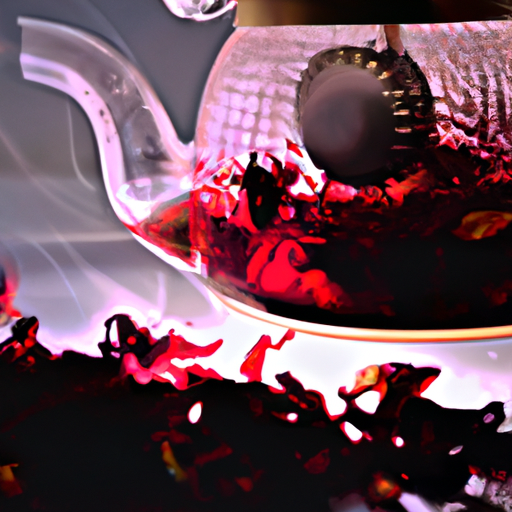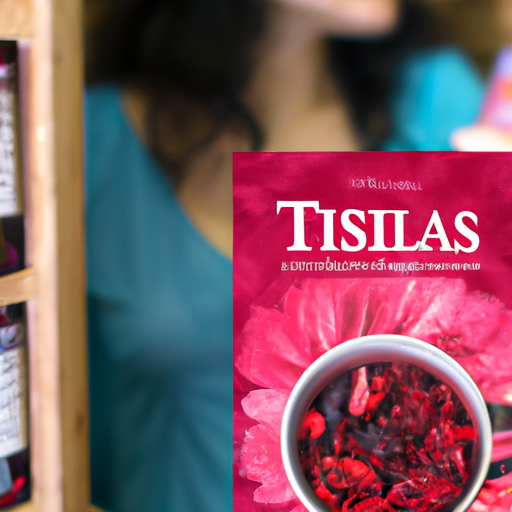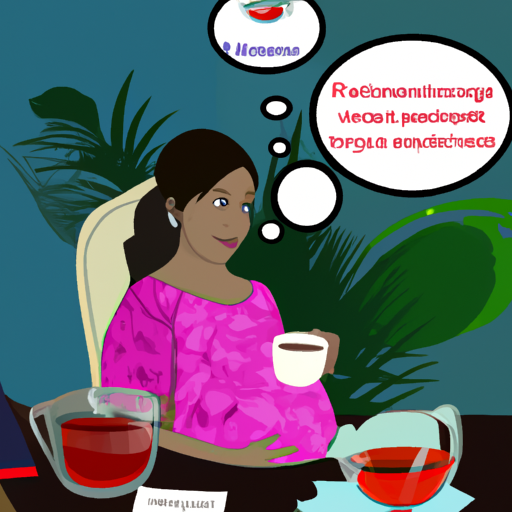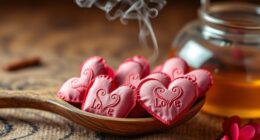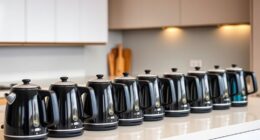I have a great fondness for a delightful cup of tea, particularly when it’s crafted from organic components. This is why I am thrilled to present to you today the method for preparing hibiscus tea!
This bright and tangy tea is not only delicious but also packed with numerous health benefits. Now, I know what you might be thinking – ‘hibiscus? Isn’t that just a flower?’
Yes, it is! But don’t let its delicate appearance fool you. Hibiscus flowers are known for their high levels of antioxidants, which can help protect your body against cell damage and reduce inflammation. Plus, this tea has been shown to potentially lower blood pressure and cholesterol levels.
So not only will you enjoy the refreshing taste of hibiscus tea, but you’ll also be doing something good for your body.
Key Takeaways
- Hibiscus tea is made from dried hibiscus flowers and can be enjoyed hot or cold.
- The tea is high in antioxidants and may have health benefits such as lowering blood pressure and cholesterol levels.
- To make hibiscus tea, you need dried hibiscus flowers, water, and sweetener, with fresh ginger being an optional addition.
- Steeping the hibiscus flowers for at least 10 minutes and straining the mixture will ensure optimal flavor and nutrient extraction.
Gather your ingredients
First, you’ll need to gather all the ingredients – grab some dried hibiscus flowers, water, sugar, and a few slices of fresh ginger if you like. When choosing your hibiscus flowers, make sure they’re bright red and not brown or dull in color. If you can’t find dried hibiscus flowers at your local grocery store or specialty shop, there are plenty of online retailers that sell them.
Ingredient substitutions are possible if you can’t find one of the listed ingredients. For example, instead of using sugar as a sweetener, try using honey or agave nectar for a healthier option. You can also skip the ginger if it’s not your thing – it won’t affect the flavor too much.
As for brewing techniques, there are several ways to make hibiscus tea – some prefer boiling the flowers in water while others suggest steeping them overnight.
Once you have all your ingredients ready to go, it’s time to boil the water. Fill up a pot with enough water to cover your hibiscus flowers and bring it to a boil on high heat. Keep an eye on it so that it doesn’t boil over!
In the next section, we’ll talk about what to do once your water is boiling and how long you should let your tea steep for maximum flavor extraction.
Boil the water
To get started, simply bring the water to a boil. When making hibiscus tea, it’s crucial that you properly boil the water. This ensures that you extract all the flavors and nutrients from the hibiscus flowers for a delicious and refreshing drink.
When boiling water for tea, there are different ways to do it depending on your preference. Some people like to use an electric kettle or stovetop pot, while others prefer using a microwave-safe container. Whichever method you choose, make sure to heat the water until it reaches boiling point, which is around 212°F or 100°C.
Boiling water isn’t just important in making hibiscus tea, but also in many other tea recipes. Different types of teas require different temperatures and steeping times, so having properly boiled water can help you achieve the perfect cup every time.
Now that we have our boiling water ready, let’s move on to adding the hibiscus flowers for a delightful taste explosion!
Add the hibiscus flowers
Now, it’s time to infuse the boiling water with the vibrant and tangy flavors of hibiscus by adding in the dried flowers.
Hibiscus flowers are not only beautiful but also have numerous medicinal uses. They contain antioxidants that help prevent damage to cells and reduce inflammation, making them a great addition to any diet.
In many cultures, hibiscus tea is more than just a beverage; it holds cultural significance. In Egypt, for example, it’s believed to help regulate body temperature and cool down hot days. In Mexico, hibiscus tea is called ‘agua de Jamaica,’ and it’s enjoyed as a refreshing drink during family gatherings or celebrations.
To make sure you get the most out of your hibiscus tea, make sure to add enough flowers (about 1/4 cup per quart of water) and let them steep for at least 10 minutes. This will ensure that all of the delicious flavors are extracted from the petals. And remember, when steeping your tea, don’t forget that patience is key!
Next up: Steep the Tea.
Steep the tea
Once the hibiscus flowers have been added, let the mixture steep for a minimum of 10 minutes to allow all the flavors to infuse. Steeping tea is an art, and there are different methods to suit different tastes. Some people prefer their tea strong with a robust flavor while others like it mild and smooth. The best time to steep hibiscus tea is when the water has just boiled.
To get the perfect taste, I recommend using loose-leaf hibiscus flowers rather than pre-packaged tea bags. This allows you to control the amount of flowers used and how long they are steeped. If you don’t have access to loose-leaf flowers, then use teabags but remember that they contain less quantity per bag.
There are two main ways of steeping hibiscus tea: hot infusion method and cold infusion method. The hot infusion method involves pouring hot water over the flowers while the cold infusion method requires leaving them in water overnight in a fridge or cool place. Both methods work well but hot infusion delivers a stronger flavor compared to cold infusion. Once you’ve allowed your mixture to steep for at least 10 minutes, it’s time to strain out any solid particles before consuming your delicious cup of hibiscus tea!
Straining your cup of freshly brewed hibiscus tea is essential after allowing it to steep for some time, as this ensures that no flower residue remains in your mouth as you drink it down! To do this, simply pour the brewed mixture through a fine mesh strainer into another container or directly into your drinking cup if it comes with one built-in! With this step completed successfully, sit back and enjoy sipping on your refreshing cup of Hibiscus Tea!
Strain the tea
As you pour your freshly brewed hibiscus tea through a fine mesh strainer, you’ll be reminded of the importance of removing any solid particles to fully appreciate the delicate flavor and smooth texture.
Straining techniques are essential in making hibiscus tea as they ensure that no impurities or residue remain in the final drink. Some people prefer using paper coffee filters or cheesecloth instead of a mesh strainer for a finer strain.
Aside from traditional straining methods, there are flavored alternatives that can enhance your hibiscus tea experience. Adding fresh herbs like mint, lemongrass, or basil into your strainer while brewing the tea can infuse additional flavors into your drink. You can also try adding fruit slices like lemon or oranges during the steeping process and let them soak together with the tea leaves for an extra fruity taste.
Now that you’ve strained your freshly brewed hibiscus tea and added some extra flare to it with infused flavors, it’s time to add sweetener to taste. Whether you prefer honey, agave syrup, stevia, or sugar – it’s entirely up to you! Sweeteners bring balance and depth to the tangy and slightly sour notes of hibiscus tea. So go ahead and add just enough sweetness until it tastes perfect for your palate.
Add sweetener to taste
To enhance the flavor of your hibiscus tea, simply add your preferred sweetener until it tastes perfect for your palate. There are various types of sweeteners that you can use to sweeten your hibiscus tea. You can add natural sweeteners like honey or agave nectar to give it a unique and subtle taste. Alternatively, you can use processed sugar or artificial sweeteners if you prefer a sweeter taste.
It’s worth noting that different types of sweetener have varying health effects. For instance, honey contains antioxidants that help boost immunity while agave nectar has a low glycemic index, making it suitable for people with diabetes. On the other hand, processed sugar and artificial sweeteners have been linked to weight gain and other health problems when consumed in large amounts.
Once you’ve added your preferred sweetener to the hibiscus tea, stir thoroughly until it dissolves completely. Now that we’ve got our perfect blend of sweetness in our hibiscus tea, let’s move on to chilling it before serving.
Chill the tea
Now that your hibiscus tea is perfectly sweetened to your liking, it’s time to pop it in the fridge and chill out for a bit.
Chilling your tea not only makes it refreshing but also has numerous benefits. Cold tea can help soothe an upset stomach and reduce inflammation in the body. It can also be a great way to cool down on a hot day.
To create a more enjoyable experience, try serving your chilled hibiscus tea with some ice cubes, fresh mint leaves or lemon wedges. The added flavors give the drink an extra zing and make it even more refreshing. You can also add some fruits like strawberries or raspberries for an extra burst of flavor.
When you’re ready to serve, pour the chilled hibiscus tea into some pretty glasses and enjoy! Whether you’re sipping on it alone or serving it at a party, chilled hibiscus tea is always a hit.
So take a moment to relax, sip on your deliciously cold tea, and enjoy all the amazing benefits that come with it.
Serve and enjoy
Get ready to savor the delicious taste of your chilled hibiscus tea by adding some ice cubes, fresh mint leaves, or juicy fruits like strawberries and raspberries for an extra burst of flavor.
Presentation is key when it comes to serving your hibiscus tea. You can serve it in a clear glass pitcher with sliced lemons and oranges on the side for a refreshing look that’s perfect for summertime gatherings.
Pairing suggestions are endless when it comes to hibiscus tea. It pairs well with sweet treats like cookies, cakes, or pastries but also goes great with savory snacks like cheese boards, crackers, and nuts. The fruity flavor of the tea complements the richness of these foods.
Now that you know how to serve up a delicious glass of hibiscus tea, let’s move on to discussing its health benefits. Did you know that this colorful brew is packed with antioxidants and anti-inflammatory properties?
Keep reading to learn more about how drinking hibiscus tea can benefit your body!
Health Benefits of Hibiscus Tea
Ah, the health benefits of hibiscus tea – it’s like a magic potion that can boost your immune system and fight off inflammation. This delicious brew is packed with nutritional properties that make it an excellent addition to any diet.
For instance, hibiscus tea contains high levels of antioxidants that help to protect the body from oxidative stress, which has been linked to several chronic diseases such as cancer and diabetes. In addition, drinking hibiscus tea may have potential side effects for those who are on certain medications or have pre-existing health conditions.
For example, some studies suggest that consuming large amounts of hibiscus tea could lower blood pressure, which may be problematic for individuals with already low blood pressure levels. It’s always essential to speak with a healthcare professional before adding any new beverage or supplement to your diet.
Now that we’ve discussed the many health benefits (and potential side effects) of hibiscus tea, let’s move onto exploring some variations of this flavorful drink.
Variations of Hibiscus Tea
You might be surprised to learn about the different ways you can enjoy hibiscus tea, from adding fruit to creating a refreshing iced tea. One of my favorite variations is to mix in some fresh berries like strawberries or raspberries. The tartness of the hibiscus pairs perfectly with the sweetness of the fruit, creating a delicious and fruity flavor combination.
Another way to switch up your hibiscus tea game is by experimenting with different brewing methods. Instead of steeping the tea bags in hot water for a few minutes, try cold brewing it overnight in the fridge. This results in a smoother and less bitter taste, perfect for those hot summer days when you need something refreshing to cool off.
Lastly, if you’re feeling adventurous, why not try mixing hibiscus tea with other types of teas? Some great combinations include green tea and mint for an extra boost of antioxidants or black tea and cinnamon for a cozy fall beverage. The possibilities are endless when it comes to making your own unique blend of hibiscus tea!
Frequently Asked Questions
How long does hibiscus tea last in the refrigerator?
Funny you should ask how long hibiscus tea lasts in the refrigerator – I just brewed a big batch myself! When it comes to storing hibiscus tea, keeping it in the fridge is key. This will help maintain its freshness and flavor for up to 5-7 days.
Make sure to store it in an airtight container to prevent any contamination or odors from other foods. When you’re ready to enjoy, simply pour over ice or heat up on the stove to your desired temperature (I prefer mine hot!).
As for brewing temperature, aim for around 200°F and steep for about 5-10 minutes depending on your taste preference. Not only is hibiscus tea delicious, but it also boasts some impressive health benefits such as aiding digestion and reducing high blood pressure.
Plus, there are endless flavor variations – try adding a squeeze of lemon or a hint of ginger for an extra kick!
Can I use dried hibiscus flowers instead of fresh ones?
Yes, you can definitely use dried hibiscus flowers instead of fresh ones to make hibiscus tea. In fact, most people prefer using dried flowers as they’re easier to find and store for a longer period of time.
To brew the perfect cup of hibiscus tea using dried flowers, simply add about 2-3 teaspoons of dried flowers per cup of water into a pot or teapot and bring it to a boil. Once the water starts boiling, reduce the heat and let it simmer for around 5-10 minutes until the color turns deep red and the flavor is strong enough to your liking.
Strain the liquid into a cup or mug and enjoy your delicious homemade hibiscus tea!
What is the ideal temperature for steeping hibiscus tea?
The ideal steeping temperature for hibiscus tea is around 200°F. It’s important to note that boiling water can actually damage the delicate flavor and aroma of the tea, so it’s best to let your water cool down slightly before steeping.
When brewing hibiscus tea, I recommend using a high-quality loose leaf tea rather than pre-packaged tea bags. This will allow you to better control the strength and flavor of your brew.
Additionally, I find that adding a bit of honey or agave nectar can help balance out the tartness of the hibiscus and enhance its natural sweetness.
Overall, with these brewing tips in mind and a little experimentation, you’ll be able to create a delicious cup of hibiscus tea that perfectly suits your tastes.
Can hibiscus tea be consumed hot or does it have to be served cold?
When it comes to hibiscus tea, there’s no one right way to enjoy it. While some people prefer to drink it cold, others like it hot. Personally, I’m a fan of sipping on a warm cup of hibiscus tea on a chilly evening.
But regardless of how you choose to consume it, there are plenty of health benefits to be had from this delicious beverage. Hibiscus tea is loaded with antioxidants and can help reduce inflammation in the body. It’s also been shown to lower blood pressure and cholesterol levels, making it a great choice for anyone looking to improve their heart health.
So whether you’re enjoying your hibiscus tea hot or cold, you can feel good knowing that you’re doing something good for your body.
Are there any potential side effects or interactions with medications when drinking hibiscus tea?
When it comes to hibiscus tea, there are some potential risks and medication interactions that you should be aware of. For starters, hibiscus tea has been known to lower blood pressure, so if you’re already taking medication for hypertension, this could cause your blood pressure to drop too low.
Additionally, if you’re taking medication for diabetes or cholesterol, hibiscus tea may interfere with the absorption of these medications. It’s also worth noting that some people have reported experiencing stomach discomfort after drinking hibiscus tea.
That being said, as long as you’re mindful of these potential risks and talk to your doctor before consuming hibiscus tea if you’re on any medications, there’s no reason why you can’t enjoy this delicious beverage in moderation!
Conclusion
In conclusion, making hibiscus tea is a simple and enjoyable process that yields a refreshing and healthy beverage. As I sipped my own cup of hibiscus tea, I couldn’t help but appreciate the vibrant red color and tangy flavor that comes from the hibiscus flowers.
The health benefits of this tea are also impressive, including lower blood pressure and improved digestion. As they say, variety is the spice of life. This rings true for hibiscus tea as well – there are endless variations to try!
Add some ginger or lemon for an extra kick, or sweeten with honey if you have a sweet tooth. The possibilities are endless and always exciting. Overall, I highly recommend giving hibiscus tea a try.
It’s easy to make, delicious to drink, and has numerous health benefits. So go ahead – steep yourself a cup of this beautiful brew and bask in its fruity goodness!

